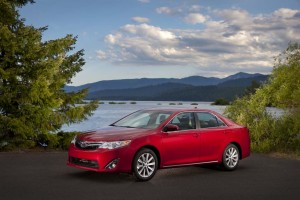Struggling to regain sales and market share momentum after months of production shortages, Toyota is lifting a few plays from its Detroit competitors – notably bumping up incentives and dumping the new Camry and other products into low-profit fleets.
The strategy may generate strong year-over-year sales numbers after the sharp downturn the maker suffered in 2011, but it suggests Toyota may be finding it harder to lure back once-loyal buyers in today’s hotly competitive market. The shift could also make it difficult for the maker to reverse its recent earnings downturn as it trades sales gains for lower margins.
(Toyota earnings slide 14% during latest quarter. Click Here for that story.)
January’s numbers initially seemed strong, Toyota posting an overall 7.5% increase, year-over-year, the maker giving much of the credit to the redesigned 2012 Camry. “This month’s results show that the all-new Camry is a hit, attracting both new and loyal customers with its class-leading performance and value,” said Bob Carter, Toyota Division group vice president and general manager at Toyota Motor Sales, U.S.A.
But a closer inspection reveals that fully half of the Camry sedans were dumped into daily rental fleets. Excluding those vehicles, Toyota sales would be up a far more modest 1% for January.
Meanwhile, Toyota has been putting more cash on the hood to lure back retail customers, as much as $2,000 on the average vehicle in recent months, according to data tracked by TrueCar.com, Edmunds.com and other research firms. That’s a lot less than the maker’s Detroit competitors, but the givebacks at Toyota have been growing significantly as it has lost its momentum in the marketplace.
That’s driving down the Japanese giant’s average transaction price, or ATP, especially on older models like the compact Corolla. In fact, research by Edmunds found that buyers last year paid about $1,500 more for the comparably sized Hyundai Elantra, at a typical $19,711.
Hyundai’s Sonata is still coming in about $500 less than the Toyota Camry, but the gap has narrowed substantially, according to analysis by USA Today, which found that five years ago the Camry was priced an average $2,000 above its Korean rival.
The overall trend is not positive for Toyota, cautioned Joe Phillippi, of AutoTrends Consulting. “Ten years ago, Toyotas sold themselves. Dealers just took orders. Now, every sale is a battle.”
Complicating matters, he said, Toyota now has 10 plants in North America to keep running, including its newest in Mississippi. Much like Detroit has traditionally done, Toyota now seems to be willing to trade profit for share, boosting incentives or dumping cars into fleets to make sure that factories keep running smoothly.
That approach “was one of the things that nearly killed Detroit,” said Phillippi, noting that since emerging from the depths of the Great Recession the domestic makers have been more willing to link production rates to actual market demand.
Ironically, it was Toyota that traditionally steered clear of fleets, preferring to match production to demand – Japanese officials often sneering at their rivals’ attempts to prop up production.
Toyota officials now promise they will trim back on fleet sales by March, insisting the recent bulge won’t turn into a long-term trend.
While many observers aren’t so certain, wondering whether Toyota will be forced to shift strategy to recover from recent problems, analyst Jim Hall, if 2953 Analytics, is less concerned.
He argues that putting the new Camry into rental fleets was something Toyota has done “historically” in order to reach out to potential new customers. “They’re just extending their marketing,” contends Hall, “which isn’t a bad idea.”
Whether it pays off in the long-term remains to be seen.

